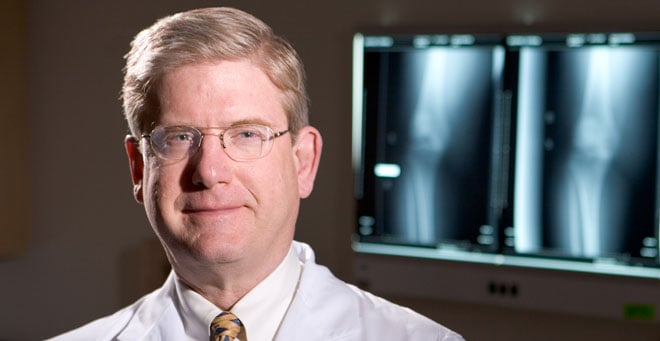 |
|
|
David Ayers, MD |
The way in which hospitals are paid for knee and hip replacement surgery will never be the same. As of April 1, the Centers for Medicare and Medicaid Services (CMS) began a first-of-its-kind bundled payment plan for more than 800 hospitals in 67 Medicare regions across the United States to align incentives for hospitals and surgeons and to improve quality and outcomes after total joint replacement. Total joint replacement surgery for knees and hips is one of the most common and fastest growing types of surgery—more than a million cases per year are performed in the United States and are growing at triple digit rates as baby boomers age.
David Ayers, MD, the Arthur M. Pappas, MD, Chair in Orthopedics, chair and professor of orthopedics & physical rehabilitation, and Patricia Franklin, MD, director of research and professor of orthopedics & physician rehabilitation, laid the groundwork for the new policy by developing FORCE-TJR, a national joint replacement registry providing patient and disease tracking, implant performance and patient-reported outcomes and quality monitoring, with a $12M grant from Agency for Healthcare Research and Quality.
“The CMS-qualified registry was the first to allow hospitals to collect critical information about a patient using an electronic platform and capture the effectiveness of a patient’s surgery,” Dr. Ayers said. “By analyzing patient data that evaluates a patient’s level of pain and function before and after joint replacement, surgeons and hospitals have been able to obtain objective data that can measure improvements in the patients quality of life.”
The FORCE-TJR model, which has been in use by hospitals to validate patient-reported outcomes, will play a critical role in the five-year CMS pilot program. Based on data collected, hospitals will be responsible for tracking quality and demonstrating value in patient care; hospitals will be held accountable for the cost of each episode of care. An episode includes the index operation as well as all medical expenses for the 90 days following the joint replacement. In the first year of the pilot, hospitals will receive a fixed rate for the entire episode of the joint replacement from the time of surgery up to 90 days post-op. Hospitals will begin to face financial risk in the second year of the program as a result of poor outcomes, or be incentivized for positive outcomes.
“The model reshapes how health care providers and hospitals think about each patient by aligning their incentives to improve patient reported outcomes and provide cost efficient care,” Ayers said. “Capturing data through FORCE-TJR can provide numerous benefits for hospitals and surgeons in bundled payment programs, such as helping to guide clinical decision-making, identifying key risk factors before and after surgery and organizing a patient’s pathway of care in ways it has never been done before.”
Related links on UMassMedNow:
New medical research targets best time for joint replacement surgery
New York Times reports on UMMS-led joint replacement study